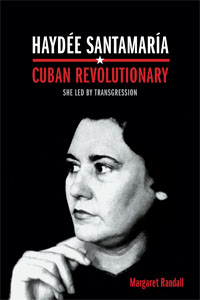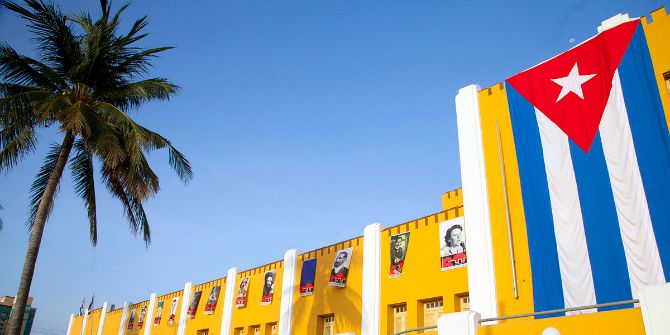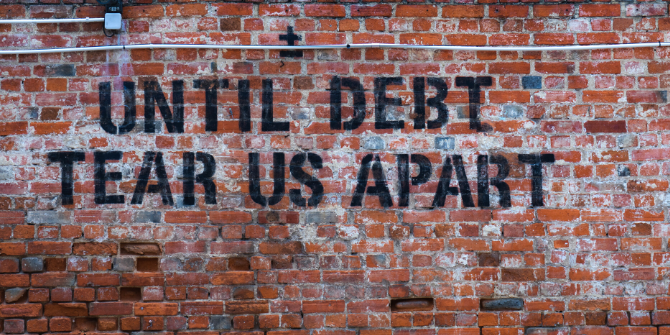While many histories of the Cuban Revolution focus on Che Guevara, Fidel Castro and Celia Sánchez, in her new book Margaret Randall turns her attention to a central, yet lesser-known, figure. Haydée Santamaría, Cuban Revolutionary: She Led By Transgression examines the life of this former revolutionary, weaving together the author’s experiences and memories as well as biographical details and interviews. Katherine Bailey praises this work for its beauty and clarity, offering a deeply personal portrait that will also be of interest to those studying Cuba pre- and post-Revolution.
This review is part of a theme week marking International Women’s Day 2016 (#IWD2016). March is Women’s History Month and LSE is celebrating with LSE Women: Making History, focusing on #LSEwomen past, present and future. If you are interested in finding out more, please visit the LSE History blog.
This book review has been translated into Spanish by Sacha Magee and Tsz Ling Wong (Spanish LN785, teacher Esteban Lozano) as part of the LSE Reviews in Translation project, a collaboration between LSE Language Centre and LSE Review of Books. Please scroll down to read this translation or click here.
Haydée Santamaría, Cuban Revolutionary: She Led By Transgression. Margaret Randall. Duke University Press. 2015.
 Haydée Santamaría was a central figure in the Cuban Revolution, and yet she remains one of the lesser-known individuals involved in this historic and momentous event. In Haydée Santamaría, Cuban Revolutionary: She Led by Transgression, Margaret Randall attempts to – and I believe largely succeeds in – providing a detailed and well-rounded examination of this former revolutionary. Other books and articles have only touched on certain aspects of Santamaría’s life or her suicide in 1980; as Randall herself notes, these texts range from extremely partial to frustratingly superficial. Haydée Santamaría, Cuban Revolutionary delves deftly into an extraordinary life, tying in the author’s own experiences and memories of Santamaría with biographical facts and interviews to present a detailed, yet personal history that speaks not only of the successes of the Revolution, but also the personal impact that such upheaval can bring. Alongside these reflections on Santamaría, the reader is also provided with various insights into the culture of Cuba during both the pre- and post-revolutionary periods. That Randall lived in Cuba for a number of years, and returned in 2014 to conduct research for this book, is evident through the confidence and conviction with which she discusses everyday life in Cuba.
Haydée Santamaría was a central figure in the Cuban Revolution, and yet she remains one of the lesser-known individuals involved in this historic and momentous event. In Haydée Santamaría, Cuban Revolutionary: She Led by Transgression, Margaret Randall attempts to – and I believe largely succeeds in – providing a detailed and well-rounded examination of this former revolutionary. Other books and articles have only touched on certain aspects of Santamaría’s life or her suicide in 1980; as Randall herself notes, these texts range from extremely partial to frustratingly superficial. Haydée Santamaría, Cuban Revolutionary delves deftly into an extraordinary life, tying in the author’s own experiences and memories of Santamaría with biographical facts and interviews to present a detailed, yet personal history that speaks not only of the successes of the Revolution, but also the personal impact that such upheaval can bring. Alongside these reflections on Santamaría, the reader is also provided with various insights into the culture of Cuba during both the pre- and post-revolutionary periods. That Randall lived in Cuba for a number of years, and returned in 2014 to conduct research for this book, is evident through the confidence and conviction with which she discusses everyday life in Cuba.
The book begins with a brief overview of the Cuban Revolution (1953-59), charting its beginnings and rise to success, and identifying other key individuals operating at this time: namely Che Guevara, Celia Sánchez and Fidel Castro. It then moves on to focus on Santamaría herself and the author’s motivations for writing the book. The text as a whole adheres to the chronology of events, so it is easy for readers with little knowledge of the Revolution to comprehend how it developed and succeeded, as well as to understand Santamaría’s role within it.
Arguably one of the most significant events that Santamaría took part in was the attack on the Moncada barracks in July 1953: hundreds of revolutionaries, including both Santamaría’s brother and her partner, were murdered during this attack, and many more were imprisoned. Santamaría had helped to plan and organise it, and she fought on the attack’s front lines; when captured, she was shown her brother’s eye and her lover’s testicle in an attempt to force her to divulge information about the movement. Instead, Santamaría replied: ‘if you did that to them and they didn’t talk, much less will I!’ (10). In this section on Moncada, Randall’s use of testimonies are especially effective as they allow readers a real insight into both the personal cost of the attack, but also the determination to succeed that sprang from it. Although the rebels failed in their attempts to take control of the barracks and the adjoining buildings, Moncada is largely recognised as the event that started the Cuban Revolution: in the years following this attack popular support for the revolutionary movement grew in size by tens of thousands. The impact that this event had can be summarised by Santamaría herself:
‘whenever we talk about anything […] we tend to say: “that happened before”, or “that happened after”. And that before and that after are before Moncada and after Moncada. After Moncada we underwent a total transformation’ (62).
 Image Credit: Moncada Barracks, 2013 (Cancillería Ecuador)
Image Credit: Moncada Barracks, 2013 (Cancillería Ecuador)
Randall also provides details of Santamaría’s childhood, her growing involvement in the Revolution (both before and after Moncada) and her work after the Revolution had succeeded, in particular at the Casa de las Américas; an institution that Santamaría founded, which continues to support and promote various art forms within Cuba. Randall writes of Santamaría: ‘She was passionate […] in her belief that art is the highest expression of revolutionary social change. At Casa de las Américas she created the perfect venue in which to demonstrate the role that art and culture can play in creating a new society’ (163). The institution that Santamaría built focused on inclusion: she extended interest to those who were marginalised in society and to artists (whatever art form they worked in) who were attempting something new, and offered them opportunities to develop their work. The photographs and letters that are included in this chapter of the book bring to life some of the vibrancy that one can imagine would have characterised this institution when Santamaría was present.
One aspect of Santamaría’s legacy that cannot be ignored when discussing her life and the memories that surround her is her suicide at age 57. There is some debate about why Santamaría took her own life and this is presented to an extent within the book, with both the author and those whom she interviewed suggesting reasons for this act. Randall discusses Santamaría’s suicide with a compassion that echoes her own feelings of grief at losing a friend, but she also allows space within her narrative for others who knew, or were related to, Santamaría to express their own feelings of anguish and also anger. Owing to this, the reader is given a realistic portrayal of both how influential a figure Santamaría was and how many she touched, as well as the impact that her death had. Although Randall confronts Santamaría’s suicide at the start of the book and indeed refers to it throughout, the life of Santamaría that is presented here is not dictated by the manner of her death: the focus of the book is on the life that she led and what she gave during this time. As Randall writes in the final sentences of her book: ‘the question shouldn’t be “why did she kill herself?” but “how did she manage to live so fully and for so long and give so much?”’ (193), and it is this impression of Haydée Santamaría that the reader takes away with them.
Margaret Randall has created an engaging book that invites the reader to share in her reflections on arguably one of the most influential, but lesser known, figures of the Cuban revolution. One of the first characteristics of this book that struck me upon reading it was the genuine warmth and admiration that was expressed towards its central figure, Haydée Santamaría. The affection and respect with which Randall discusses Santamaría cannot be overlooked as it is this tone and style that help to create such a personal portrait of this significant woman, and which encourage readers to read on, regardless of their prior knowledge of the Cuban Revolution. As Randall herself states in the introduction: ‘this is not a biography […] This is an impressionist portrait, written by a poet rather a historian’ (13). Although academic in nature, the book is remarkably accessible and written, as Randall suggests, with beauty as well as clarity in mind.
Kate Bailey is a PhD student in the History Department at Lancaster University, UK. Her research is currently examining the memorialisation of the ‘disappeared’ in Guatemala, looking at the use of street art, art exhibitions, museums and public events as forms of alternative memorial. Follow her on Twitter here: @KH_Bailey.
Note: This review gives the views of the author, and not the position of the LSE Review of Books blog, or of the London School of Economics.
Mientras que muchas historias sobre la Revolución Cubana se centran en el Ché Guevara, Fidel Castro y Celia Sánchez, Margaret Randall en su nuevo libro vuelve su atención sobre una figura central, aunque menos conocida. Haydée Santamaría, Revolucionaria Cubana: Liderazgo por Transgresiónexamina la vida de esta ex revolucionaria entrelazando experiencias y memorias de la autora con detalles bibliográficos y entrevistas. Katherine Bailey elogia este trabajo por su belleza y claridad ofreciendo un relato profundamente personal que interesara a aquellos estudiosos de los periodos previo y posterior a la Revolución Cubana.
Haydée Santamaría, Revolucionaria Cubana: Liderazgo por Transgresión. Margaret Randall. Duke University Press. 2015.
 Review translated by Sacha Magee and Tsz Ling Wong (Spanish LN785, teacher Esteban Lozano).
Review translated by Sacha Magee and Tsz Ling Wong (Spanish LN785, teacher Esteban Lozano).
Haydée Santamaría fue una figura central en la revolución cubana y sin embargo permanece como uno de los individuos menos conocidos involucrados en este histórico y trascendental evento. En Haydée Santamaría, Revolucionaria Cubana: Liderazgo por Transgresión, Margaret Randall intenta dar -y yo creo que en general con éxito- un análisis detallado y completo de esta ex revolucionaria. Otros libros y articulos se han concentrado solo en ciertos aspectos de la vida, o su suicidio en 1980, de Haydée Santamaría; como nota Randall estos textos se mueven entre la extrema parcialidad a la frustrante superficialidad. Haydée Santamaría, Revolucionaria Cubana profundiza hábilmente en una vida extraordinaria, atando las propias experiencias y memorias de Santamaría con hechos bibliográficos y entrevistas para acabar presentando una detallada, así como personal historia, que habla no solo del éxito de la Revolución sino del impacto personal que tal convulsión puede generar. Junto a esas reflexiones sobre Santamaría, se ofrecen al lector visiones diferentes de la cultura cubana en los periodos pre y post revolucionarios. Por la confianza y convicción con la que se desenvuelve Randall al tratar la vida cotidiana en Cuba, es evidente que vivió allí algunos años, volviendo de nuevo en 2014 para completar investigaciones para esta obra.
El libro comienza con una visión general de la Revolución Cubana (1953-59), mapeando sus comienzos hasta la llegada del éxito e identifica otros individuos clave que operaban en ese periodo concretamente Ché Guevara, Celia Sánchez y Fidel Castro. De ahí pasa a centrarse en Santamaría y las motivaciones que llevaron a la autora a escribir el libro. El texto en su totalidad se adhiere a la cronología de los eventos, de ahí que sea fácil para los lectores con poco conocimiento sobre la Revolución comprender cómo se desarrolló y alcanzó el éxito, y entender el papel jugado por Santamaría en la causa revolucionaria.
Uno de los eventos más significativos en los que participó Santamaría posiblemente fuera el ataque a los cuarteles de Moncada en julio de 1953: cientos de revolucionarios incluyendo al hermano y al compañero de Santamaría, fueron masacrados durante este ataque y muchos mas fueron hechos prisioneros. Santamaría había ayudado a planearlo y organizarlo, y ella luchó en la primera línea del ataque; cuando fue capturada, le mostraron el ojo de su hermano y un testículo de su amante, en un intento de forzarla a divulgar información sobre el movimiento.
En cambio, Santamaría respondió: “si eso les hicisteis a ellos y no hablaron, mucho menos lo hare yo”. (10) En esta sección sobre Moncada, el uso de los testimonios de Randall es especialmente efectivo porque proporcionan información a los lectores tanto sobre el coste personal del ataque, como de también la determinación para el éxito que de allí surgió. Aunque los rebeldes fallaron en sus intentos para tomar cuarteles y los edificios adyacentes, Moncada es reconocido en gran medida como el caso que empezó la Revolución Cubana: en los años sucesivos a este ataque, el apoyo popular por el movimiento revolucionario creció en decenas de millares. El impacto de este evento puede resumirse como lo hizo la misma Santamaría:
Siempre que hablamos sobre cualquier cosa (…) tendemos a decir “eso ocurrió antes” o “eso ocurrió después”. Y también que ese antes y que ese después, son antes de Moncada y después de Moncada. Después de Moncada, nosotros experimentamos una transformación total (62).
 Image Credit: Moncada Barracks, 2013 (Cancillería Ecuador)
Image Credit: Moncada Barracks, 2013 (Cancillería Ecuador)
Además, Randall proporciona detalles de la infancia de Santamaría, su creciente implicación en la Revolución (ambos, antes y después Moncada) y su trabajo después del triunfo de la Revolución, particularmente en la Casa de las Américas: una institución que Santamaría fundó, que continúa apoyando y que promociona varias formas de arte dentro de Cuba. Randall escribe sobre Santamaría:” Ella era apasionada en su creencia de que el arte es la mayor expresión de cambio social revolucionario”. En Casa de las Américas creó el espacio perfecto para demostrar la función que el arte y la cultura pueden tener a la hora de crear una sociedad nueva” (163). La institución que Santamaría creó centró en la inclusión: extendió el interés por los marginados en sociedad y a artistas, cualquiera la forma de arte en la que trabajaran, aquellos que intentaban algo nuevo, y les ofreció oportunidades para desarrollar su trabajo. Las fotografías y las cartas que se incluyen en este capítulo del libro rememoran parte de la vitalidad que se puede imaginar habrían caracterizado esta institución cuando Santamaría estaba en ella.
Uno aspecto del legado de Santamaría que no puede ser ignorado cuando se habla su vida y las memorias sobre ella es su suicidio a los 57 años. Hay algún debate sobre por qué Santamaría se suicidó y esto es presentado hasta cierto punto en el libro, con ambos, el autor y aquellos a quienes entrevistó, se sugieren motivos por este acto.
Randall habla del suicidio de Santamaría con una compasión que se hace eco de su pena por la pérdida de una amiga, pero también deja espacio dentro de su narrativa para otros que la conocieron a, o estuvieron relacionados con Santamaría, para que expresen su propia angustia y también rabia. Debido a esto, se le da al lector una representación realista de la influencia de Santamaría y de la mucha gente a la que conmovió, además del impacto de su muerte. Aunque Randall confronta el suicidio de Santamaría al comienzo del libro y, de hecho, se refiere a él a lo largo del libro, la vida de Santamaría que se presenta aquí no es dictada por la forma de su muerte: el foco del libro está en la vida que llevó y lo que dio durante esta época. Como Randall escribe en el final de su libro: la pregunta no debería ser ” ¿Por qué se suicidó? ” sino ” ¿Cómo consiguió vivir tan plenamente y por tanto tiempo, y también dar tanto? “(193) y esta es la impresión de Haydée Santamaría que el lector se lleva con él.
Margaret Randall ha creado un libro atractivo que invita al lector a compartir su reflexión sobre una de las figuras más influyentes, pero menos conocidas, de la revolución cubana. Una de las primeras características de este libro que me impresionó al leerlo fue la calidez y admiración que se expresaba hacia su protagonista, Haydée Santamaría. El afecto y el respeto con el que Randall habla sobre Santamaría no pueden pasarse por alto porque este tono y estilo ayudan a crear un retrato tan personal de esta importante mujer y anima a los lectores a seguir leyendo, independientemente de su conocimiento previo de la revolución cubana. Como Randall afirma en la introducción: “esto no es una biografía […] Esto es un retrato impresionista escrito por un poeta más que un historiador” (13). Aunque en estilo académico, el libro es notablemente accesible y está escrito, como Randall sugiere, con belleza y una mente clara.
Kate Bailey es una estudiante de doctorado en el Departamento de Historia de la Universidad de Lancaster, Reino Unido. Su investigación está actualmente examinando la conmemoración de los “desaparecidos” en Guatemala, estudiando el uso del arte callejero, las exposiciones de arte, los museos y los eventos públicos como formas de memorial alternativo. Síguela en Twitter aquí: @KH_Bailey. Leer otras reseñas de Kate Bailey.
Nota: Esta revisión presenta las opiniones del escritor, y no la posición del LSE Review of Books blog, ni de la London School of Economics.







